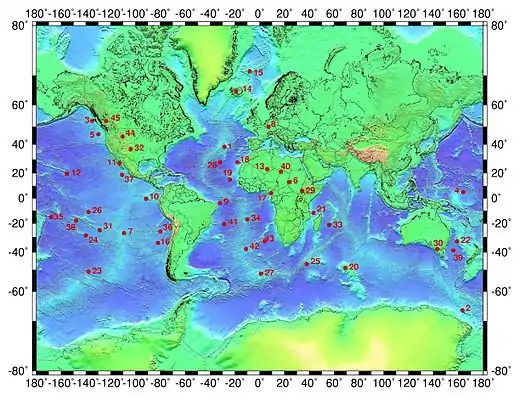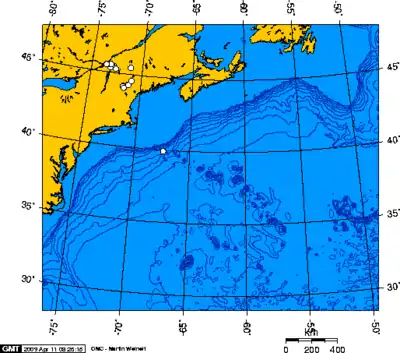New England hotspot
The New England hotspot, also referred to as the Great Meteor hotspot, is a long-lived volcanic hotspot in the Atlantic Ocean. The hotspot's most recent eruptive center is the Great Meteor Seamount, and it probably created a short line of mid to late-Cenozoic age seamounts on the African Plate but appears to be currently inactive.[1]


The New England hotspot track is used to estimate the movement of the North American Plate away from the African Plate from early Cretaceous period to the present.[1]
The New England hotspot has been overridden by the Mid-Atlantic Ridge.
Geologic history
About 200 million years ago, just as the Atlantic Ocean was starting to form, the area northwest of Hudson Bay was over the New England hotspot. About 50 million years later, as the Atlantic Ocean opened slightly, the plume was under present-day Ontario, creating numerous kimberlite fields. About 125 million years ago, the hotspot created the magma intrusions of the Monteregian Hills in southern Quebec, Canada. The lack of an obvious track west of the Monteregian Hills may be due either to failure of the plume to penetrate the Canadian Shield, to the lack of recognizable intrusions, or to strengthening of the plume when it approached the Monteregian Hills. About 25 million years later, the hotspot created the magma intrusions of the White Mountains in New Hampshire. As the North American Plate moved westward, it created the New England Seamounts between 80 and 100 million years ago. When the hotspot created the New England Seamount chain, it might have been the seventh or eighth most active hotspot of the period. The hotspot declined in activity after it made Nashville Seamount about 83 million years ago. The hotspot created the Corner Rise Seamounts about 75 million years ago. Renewed volcanic activity formed the Seewarte Seamounts 10–20 million years ago.[2]
See also
References
- Age Progressive Volcanism in the New England Seamounts and the opening of the Central Atlantic Ocean Retrieved on 2007-10-05
- A Hundred-Million Year History of the Corner Rise and New England Seamounts Archived 2006-05-03 at the Wayback Machine Retrieved on 2007-08-05